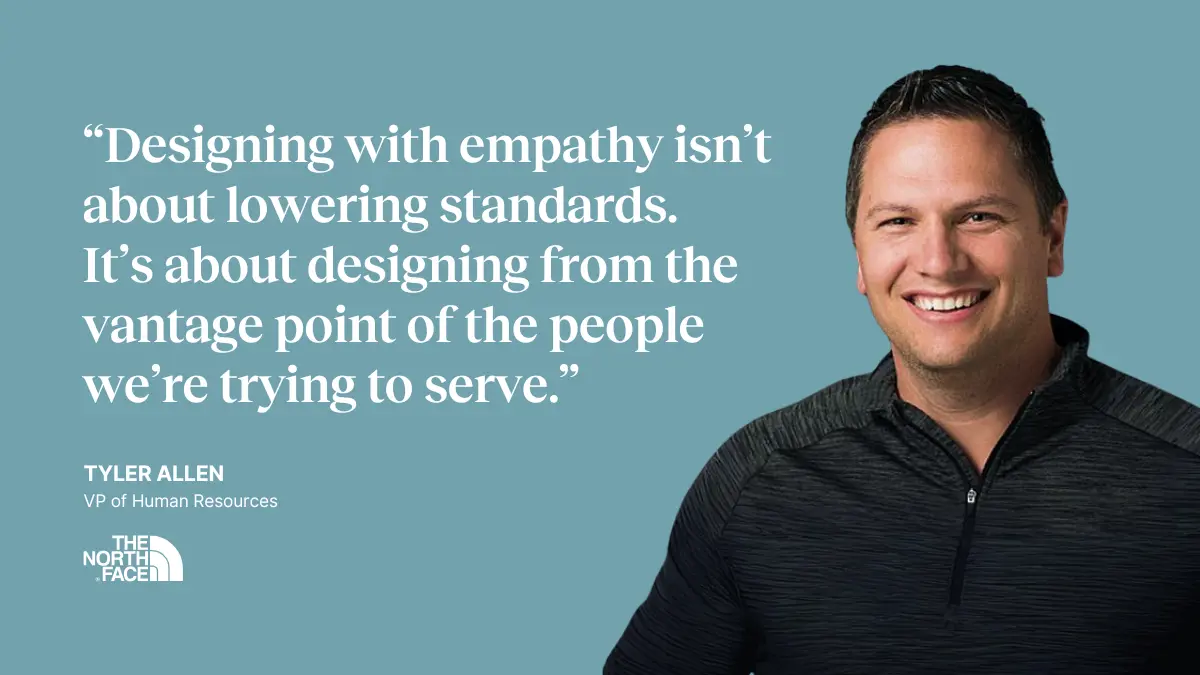Beyond the desk: a guidebook for supporting every corner of your workforce

Dispersed workforces present a unique challenge for HR teams tasked with delivering benefits that feel both fair and relevant. This blog unpacks proven strategies—backed by real-world examples and data—that help HR leaders build inclusive, high-impact programs that resonate across corporate, retail, and frontline teams.
HR leaders managing dispersed workforces—across corporate offices, frontline retail staff, and warehouse teams—face one of the most complex challenges in benefits today: how to support everyone equitably and effectively with a unified strategy.
In a recent Missing Chapters conversation, Tyler Allen, VP of HR at The North Face, shared real-world insights that go beyond theory. His experience offers practical takeaways for building inclusive, high-impact benefits strategies for teams that don’t all sit behind a desk.
Why today’s workforce is more dispersed than ever, and what that means for HR
Today’s workforce spans corporate headquarters, storefronts, home offices, and warehouses. Between hybrid models, global expansion, and an increasing reliance on frontline roles, many employers are now managing employee populations with vastly different work environments, schedules, and access to resources.
This shift isn’t just logistical—it’s cultural. Employees expect flexibility, personalization, and connection. HR leaders are at the center of this transformation, responsible for building strategies that meet the diverse needs of a distributed workforce, while still aligning with the organization’s goals and budget.
The challenge: delivering benefits that feel fair and relevant
Dispersed workforces present one of the most complex challenges in benefits today: how to support everyone equitably and effectively—across all job types, locations, and access levels—with a unified strategy.
In our conversation with Tyler, he explained how his team moved beyond theory to build programs that meet real-world needs. “Designing with empathy isn’t about lowering standards. It’s about designing from the vantage point of the people we’re trying to serve,” he shared.
Ignoring those needs can have consequences. 40% of employers believe workers leave their jobs to find better benefits elsewhere. Among frontline workers, 62% say they feel overlooked when it comes to company perks and benefits.

Adopt a multi-channel approach to employee listening
Understanding employee needs starts with listening, but for dispersed teams, listening has to go beyond traditional surveys.
HR leaders are layering tools to get a full, real-time picture:
- Pulse check-ins via mobile or QR codes in breakrooms
- Enrollment surveys tied to benefit decisions
- Store visits and 1:1 conversations with frontline staff
- Feedback loops facilitated through district and team managers
This broader listening approach surfaces the quieter voices—those that don’t always speak up in annual surveys.
And it’s becoming the norm: 57% of HR leaders run employee feedback programs at least quarterly. But frequency alone isn’t enough. Feedback must translate into visible action, or trust erodes.
Design benefits at the intersection of data, people, and budget
Benchmarking your benefits against competitors is table stakes, but the best strategies are built at the intersection of:
- What the market offers
- What your employees value
- What your organization can sustainably support
Reconciling those inputs is messy. Budgets are tight. Needs arise in unexpected ways. Surveys can miss nuance. But starting with the question “What problem are we trying to solve?” keeps strategy grounded in purpose, not just numbers.

Use targeted solutions to drive equity and impact
Uniformity may feel fair—but it often leads to wasted spend and missed impact. Equity means meeting employees where they are, with solutions that reflect their real-life contexts.
In our conversation, Tyler shared a compelling example: rather than applying a blanket rideshare benefit across the company, his team identified a specific site where employees were struggling with transit access. The more impactful solution? A localized commuter subsidy tailored to that location’s needs. It was simple, targeted, and solved a real problem.
These kinds of flexible, place-based adaptations often deliver greater value than broad programs that overlook context.
Use pilots to turn employee insights into action
Some of the most impactful programs aren’t vendor-driven or high-cost—they come from internal innovation and employee-led initiatives.
At The North Face, Tyler and his team launched several low-cost, high-impact programs:
- Mental health first aid: Training team members to offer emotional support, creating a trusted peer-to-peer care channel
- Retail apprenticeships: Giving store employees hands-on experience in corporate roles
- Volunteer career coaching: Empowering employees to guide peers on development and growth
These efforts don’t require massive budgets, but they create lasting cultural value, deepen trust, and address unmet needs in a scalable way.
Treat communication as part of the benefit
Even the best benefits don’t matter if employees don’t understand or remember them. This is a persistent challenge for dispersed teams—especially those who don’t sit behind a desk or regularly check email.
That’s why communication needs to be embedded into the delivery of the benefit itself:
- QR codes posted in high-traffic areas like breakrooms
- Manager-led huddles with consistent talking points
- Mobile-friendly portals and printed one-pagers
- Store or site leader toolkits for local rollouts
Still, awareness remains a challenge. Only 57% of employees feel fully informed about their benefits, and 1 in 4 feel only slightly—or not at all—educated.
More communication isn’t the answer. Better communication is. Clear, repeated, and locally delivered messages drive adoption far more than flashy email campaigns.
Build with empathy, deliver with intent
There’s no perfect playbook for building benefits for a distributed workforce, but there are clear patterns among the teams doing it well:
- They listen in multiple ways, consistently and respectfully
- They balance flexibility with consistency
- They treat communication as part of the product
- They start small, test, and adapt
The HR leaders who are closest to the work—such as those visiting job sites, holding listening sessions, and refining ideas—are the ones building programs that employees actually use and appreciate.
When you design with empathy and execute with clarity, you don’t just build compliant benefits. You build meaningful, inclusive, and impactful experiences that serve the whole workforce.
Watch the full webinar + join the next conversation
Want to dive deeper into the Missing Chapters discussion with Tyler? Watch the full recording here.
Join our next Missing Chapters session and become part of a community of HR leaders redefining how work gets done.




.webp)

.webp)